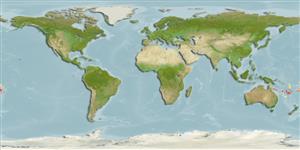>
Blenniiformes (Blennies) >
Tripterygiidae (Triplefin blennies) > Tripterygiinae
Etymology: Enneapterygius: Greek, ennea = nine times + Greek, pterygion = little fin (Ref. 45335).
More on author: Fricke.
Environment: milieu / climate zone / depth range / distribution range
Ecología
marino asociado a arrecife; rango de profundidad 0 - 15 m (Ref. 54980). Tropical
Western Central Pacific: New Caledonia and Vanuatu.
Tamaño / Peso / Age
Maturity: Lm ? range ? - ? cm
Max length : 3.7 cm SL macho / no sexado; (Ref. 54980)
Short description
Claves de identificación | Morfología | Morfometría
Espinas dorsales (total) : 14 - 17; Radios blandos dorsales (total) : 7 - 10; Espinas anales: 1; Radios blandos anales: 17 - 21. Small supraorbital tentacle; first dorsal fin shorter by 50% than second dorsal fin; females translucent pale gray to white with red or dark brown double bars on body; an oblique, red to dark brown band from upper lip to eye; a red or dark brown blotch on opercle and pectoral-fin base; transparent median fins with red rays; males red with faint, dark brown bars; chest and lower half of head dark gray with scattered black spots almost as large as pupil. Dorsal rays III + XI-XIV + 7-10; lateral line interrupted, 14-18 + 16-20; mandibular pores 4-5 + 2 + 4-5 (Ref. 54980).
Adults are found in shallow waters, surge channels and tidal pools around fringing reefs where wave action is high; some found in the big surf, oxygen-rich habitat (Ref. 27223). Eggs are hemispherical and covered with numerous sticky threads that anchor them in the algae on the nesting sites (Ref. 240). Larvae are planktonic which occur primarily in shallow, nearshore waters (Ref. 94114).
Life cycle and mating behavior
Madurez | Reproducción | Puesta | Huevos | Fecundidad | Larva
Fricke, R., 1997. Tripterygiid fishes of the western and central Pacific, with descriptions of 15 new species, including an annotated checklist of world Tripterygiidae (Teleostei). Theses Zool. 29:1-607. (Ref. 27223)
IUCN Red List Status (Ref. 130435: Version 2024-1)
Threat to humans
Harmless
Human uses
Pesquerías: sin interés
Herramientas
Special reports
Download XML
Fuentes de Internet
Estimates based on models
Preferred temperature (Ref.
123201): 24.7 - 28.7, mean 26.6 °C (based on 263 cells).
Phylogenetic diversity index (Ref.
82804): PD
50 = 0.5000 [Uniqueness, from 0.5 = low to 2.0 = high].
Bayesian length-weight: a=0.00617 (0.00288 - 0.01322), b=3.04 (2.86 - 3.22), in cm total length, based on LWR estimates for this (Sub)family-body shape (Ref.
93245).
Nivel trófico (Ref.
69278): 3.2 ±0.3 se; based on size and trophs of closest relatives
Resiliencia (Ref.
120179): Alto, población duplicada en un tiempo mínimo inferior a 15 meses (Preliminary K or Fecundity.).
Fishing Vulnerability (Ref.
59153): Low vulnerability (10 of 100).
